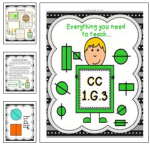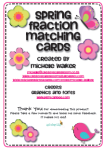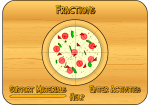Unit Goal
The learner will learn about fractions of shapes.
Unit Objective
-
The learner will make equal parts of a whole
-
The learner will describe Equal parts of whole objects
-
The learner will make halves and fourths of circles and rectangles
- The learner will describe fractional parts of a given picture in word (one fourth) and fraction forms (¼)
- The learner will complete a constructive response activity in which they have to partition a cookie or pizza into halves or fourths and explain how it would be shared with them and others.
Background and Rationale
-
The key concepts for the lesson- This lesson will teach students about partitioning circles, squares, and rectangles into halves and fourths.
-
How this lesson builds on and connects with previous lessons- Students have previously learned how to identify equal and unequal shares. In this lesson students will partition circles, squares, and rectangles into equal shares of halves and fourths.
- How you will build on this lesson in subsequent lessons- In subsequent lessons students will analyze fractional parts and learn that the larger the denominator the smaller the fractional part (portion)
If applicable, how will you provide differentiated activities and assessments for learners with varying abilities, experiences, etc.?]- Below level (refine) students will sort fractional pictures into halves and fourths and equal and unequal shares. On level (reinforce) students will partition shapes into equal halves and fourths using horizontal, vertical, and diagonal lines. Above level (extend) students will color and label fractional parts as one half, two halves, one fourth, two fourths, three fourths, and four fourths. They will also define equivalent fractions two fourths is the same as one half; two halves and four fourths are the same as one whole.
Lesson Objectives
Objective |
Bloom’s Verb |
|---|---|
|
The learner will make equal parts of a whole. |
Creating |
| The learner will describe equal parts of whole objects. | Analyzing |
|
The learner will make halves and fourths of circles and rectangles. |
Creating |
|
The learner will describe fractional parts of a given picture in word (one fourth) and fraction forms (¼). |
Understanding |
| The learner will complete a constructive response activity in which they have to partition a cookie or pizza into halves or fourths and explain how it would be shared with them and others. | Evaluating |
Bloom’s Taxonomy
creating, analyzing, evaluating, applying, and understanding
Curriculum Standards
Partition circles and rectangles into two and four equal shares, describe the shares using the words halves, fourths, and quarters, and use the phrases half of, fourth of, and quarter of. Describe the whole as two of, or four of the shares. Understand for these examples that decomposing into more equal shares creates smaller shares.
Technology Integration (ISTE Standards):
Critical Thinking, problem solving and decision making
Students use critical thinking skills to plan and conduct research, manage projects, solve problems, and make informed decisions using appropriate digital tools and resources.
- Identify and define authentic problems and significant questions for investigation
Learning and Innovation Skills (P21.org)
Reason Effectively
-
Use various types of reasoning (inductive, deductive, etc.) as appropriate to the situation
Make Judgments and Decisions
-
Effectively analyze and evaluate evidence, arguments, claims and beliefs
-
Analyze and evaluate major alternative points of view
-
Interpret information and draw conclusions based on the best analysis
Life and Career Skills (P21.org)
Work Independently
-
Monitor, define, prioritize and complete tasks without direct oversight
Information, Media, and Technology Skills (P21.org)
Access and Evaluate Information
-
Access information efficiently (time) and effectively (sources)
-
Evaluate information critically and competently
Materials
-
vocabulary words and definition cards for -halves, fourths, partition, and equal parts
-
fraction pictures to sort as halves and fourths for refine activity
- circles, squares, and rectangles worksheet to partition for reinforce activity
- fraction pictures to color as one half, two halves, one fourth, two fourths, three fourths, and four fourths
- Pizza Puzzle to Partition
-
constructive response performance activity- pizza or cookie share
- fraction cards to match-picture to word to fraction
Thinking Routine
Lesson Introduction
Show students a pizza puzzle that has been partitioned into different shares (sizes). Then give students different shares and review equal and unequal parts of a whole.
Lesson Procedures and Activities
-
The teacher will introduce lesson vocabulary. (5 minutes)
-
The student will write, define, and illustrate each vocabulary word in his/her math notebook. (10 minutes)
-
The students and teacher will go around the school and take pictures of circles, squares, and rectangles and upload them on a Google slide.
-
The teacher will divide the shapes with Smartboard markers and have the students to discuss what they see as the thinking routine, “What Makes You Say That” is used.
-
The student will then partition (horizontally, vertically, and diagonally) three circles, three squares, and three rectangles into equal halves and fourths. (10 minutes)
-
The student will sort the shapes as halves and fourths as the teacher uses the thinking routine “What Makes You Say That?” (5 minutes)
-
The teacher will introduce constructive response activity in which students will be given a choice of sharing a cookie or pizza (5 minutes)
-
The student will divide the cookie or pizza into halves or fourths and explain how the cookie will be shared. (15 minutes)
-
The student will work with a partner to match a fractional picture to a given scenario. (5 minutes)
Lesson Closure
The lesson closure will include an “ I Have Who Has” fractions game.















